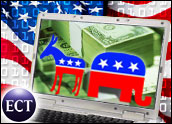
There is a huge CRM lesson embedded in the results of the Iowa caucuses, and it has almost nothing to do with which on-demand CRM application a candidate used to track everything.
The story of Iowa is one of new-fangled technologies, such as blogging and social networks. Both winners — Republican Mike Huckabee and Democrat Barack Obama — as well as some notable runners up such as Democrat John Edwards were able to create buzz and get their voters to the caucuses, spending less than well heeled competitors and largely flying under the radar of traditional news organizations.
Young Voters Unite
The Washington Post quoted Obama’s senior campaign manager, David Axelrod saying, “Younger voters participated in far greater numbers than ever before,” and he credited the youth vote for Obama’s success. The young voters demographic is defined as people in the 17 to 29 age group (17 year olds who will be 18 at election time were included).
According to various sources, candidates used a plethora of social networking sites, including Facebook, YouTube and MySpace, to organize support. A story on the Wired Blog Network said, “Iowa PIRG and Young Voter PAC had worked hard over the past few months to turn out young voters. Iowa PIRG used social networking sites such as Facebook to organize and keep each other updated. The group trained 250 college students to prod and poke their peers into showing up at the caucuses Thursday night.”
“The social networking helps — it’s definitely a platform to launch off to get organized,” said Ellynne Bannon of the Iowa and Student PIRG’s New Voters Project. “But we followed all of that up with face-to-face interaction.”
Social Networking Trumps War Chests
So what’s going on here?
It appears that money might have proven to be an insulator of the candidates with the most of it (Democrat Hillary Clinton and Republican Mitt Romney). It kept them cocooned in the secure but erroneous knowledge of the rightness of their respective approaches. Actually, money proved to be a semi-conductor since those with lesser amounts of it may have done better because it forced them to leverage the inexpensive social nets.
Ironically, on the Democrats’ side, the voters wanted change while Hillary was selling competence/experience. She missed understanding which message would be most effective despite the fact that the knowledge was available if she only would have asked people the right questions. When she should have been talking more about change, she went on what was largely touted as a “charm offensive” to show the softer side of her competence — talk about blowing it!
Huckabee, on the other hand, had the audacity to challenge the Bush administration’s ham-handed approaches to domestic and foreign policy — was he just lucky or did he know he was on solid ground? Romney, who turns out to have been clueless on the dynamics, said Huckabee owed Bush an apology. Too late, he tried to soften the blunder and create separation between himself and the president.
Beyond Reaching
Social networking covers a lot of ground. Many people still think of it as something you use to reach a lot of people, and while that’s true, that’s not the most relevant aspect here. The successful candidates used social networking not simply to reach but to influence, and what worked for those who chose to experiment was the idea of communities of interest.
You don’t need modern technology to have communities of interest, but it helps if you want information to trickle back to the hub rather than being stranded out at the spokes of a group. Eric von Hippel’s book, Democratizing Innovation has great resonance here. If you have read the book, you might recall a long passage about the impact of communities of interest on the rapid evolution of the steam engine at the beginning of the Industrial Age.
Despite being competitors in other fields, users of early steam engines formed associations where they discussed the latest innovations, captured feedback and presented that feedback to engine builders to accelerate design improvements. Their work took the steam engine from a large and barely useful contraption to literally become the engine of the industrial age in one (human) generation. Retail politics in Iowa and New Hampshire are tailor made for social networking generally and communities of interest specifically.
Pre-Internet Success
Closer to home or politics, the American Civil Rights movement can be seen as the result of social networking with churches forming the backbone of political organization. Freedom of religion and freedom of assembly are two ideas ensconced in the U.S. Constitution that even Jim Crow laws could not thwart, and they formed the basis for the movement’s eventual success.
The success of social networking in the still-young 2008 presidential race should not be seen as revolutionary — it has been a part of American political life for a long time, even before it had a name. What’s interesting to me is that it has the power to trump even money as both political lubricant and glue. Consider this: in 2004 candidates like Howard Dean discovered the power of the Internet as a fund-raising vehicle, but the funds were used for a lot of politics as usual. Just four years later, the Internet is being used to bypass the fund-raising to go directly to a new kind of high-impact and low-cost politics.
Talk about evolution!
Denis Pombriant is the managing principal of the Beagle Research Group, a CRM market research firm and consultancy. Pombriant’s research concentrates on evolving product ideas and emerging companies in the sales, marketing and call center disciplines. His research is freely distributed through a blog and Web site. He is working on a book and can be reached at [email protected].












































Social CRM
See all Social CRM